消费者行为学第二版付国群主编第十章
- 格式:ppt
- 大小:458.50 KB
- 文档页数:56

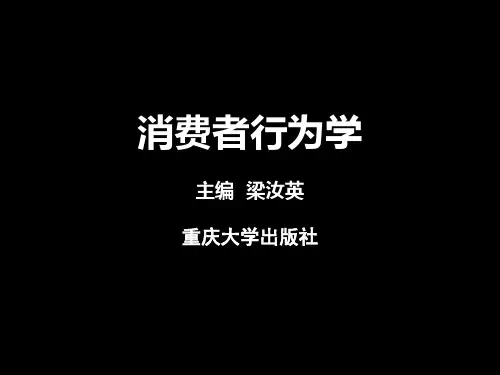
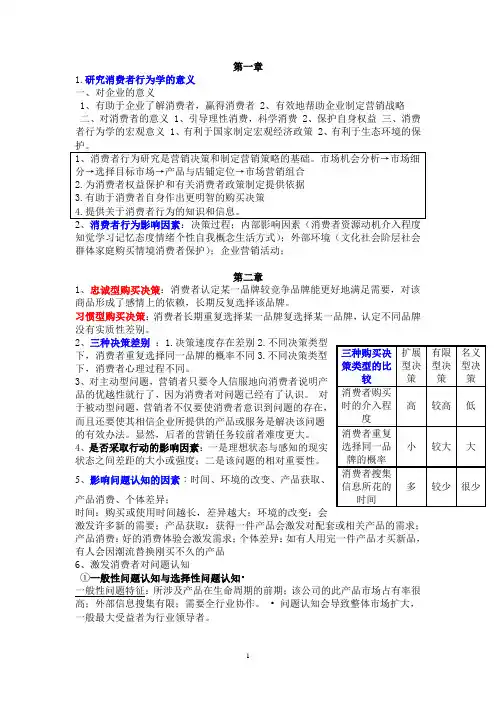
知觉学习记忆态度情绪个性自我概念生活方式);外部环境(文化社会阶层社会激发许多新的需要;产品获取:获得一件产品会激发对配套或相关产品的需求;产品消费:好的消费体验会激发需求;个体差异:如有人用完一件产品才买新品,有人会因潮流替换刚买不久的产品6、激发消费者对问题认知①一般性问题认知与选择性问题认知•一般性问题特征:所涉及产品在生命周期的前期;该公司的此产品市场占有率很高;外部信息搜集有限;需要全行业协作。
•问题认知会导致整体市场扩大,一般最大受益者为行业领导者。
②选择性问题针对某一特定企业的产品或品牌。
•影响消费者的理想状况•影响对现实状况的看法•常用手段:广告、公共关系等。
•认知时机:理想时机,在潜在问题暴露前③激发问题认知的方法 1. 通过改变消费者对理想状态与现实状态的认识来影响两者间的差距。
2. 通过影响消费者对现有差距的重要性的认识来激发消费者的问题认知。
3、通过广告或促销手段对现有状况认识。
④问题认知的时机,消费者因人而异、(事前和事后);事前营销对消费者和企业都更加有利⑤压制消费者对问题的认知,消费者对某些有害身体健康的产品的认知往往是营销者要避免的。
在有限型和名义型决策的条件下,企业不希望顾客对其产品所存在的问题产生认知。
7、影响外部信息搜集的因素•从经济分析:当边际成本=边际收益时,消费者停止搜索。
影响边际成本的因素:购物距离及交通费用、时间的机会成本。
•从决策角度分析:主要考虑三种因素,–购买产品的风险(包括:知识的不确定性与选择的不确定性)–与消费者特征相关的因素,如:个性、人口特征、消费者知识水平等。
–情景因素,如:时间;购买任务、性质;消费者情绪等8、进行大量信息搜集的前提:消费者参与程度高;可预见风险高;缺乏产品知识和经验;清楚的目标;时间压力小;高价格;产品差异大;搜寻信息的有效成本第三章1、在购买意向形成后影响最终购买的因素:他人态度;购买风险;意外情况出现。
2、冲动性购买:进入商店前没有购买计划或意图,进入商店后基于突然的念头马上实施购买行动。
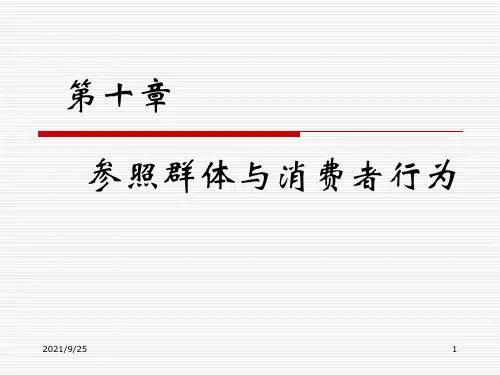
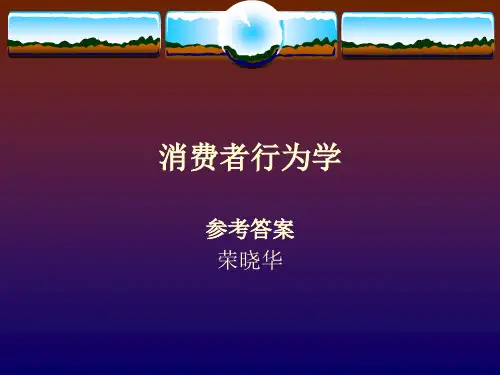
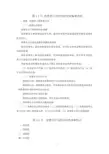
第1-1节消费者行为学的研究对象和内容一、消费、消费者与消费者行为(一)消费与消费者消费含生产消费和生活消费消费者是从事消费活动的主体,指那些对某种商品或服务有现实或潜在需求的人。
消费者分为现实消费者和潜在消费者现实消费者:指对某种商品有现实需要,并实际从事商品购买或使用活动的消费者。
潜在消费者:指当前尚未购买、使用或需要某种商品,但在未来可能对其产生需求并付诸购买及使用的消费者。
消费者需求的潜在状态是由于缺乏某种必备的消费条件所致:(1)需求意识不明确(2)需求程度不强烈(3)购买能力不足(4)缺乏有关的商品信息(二)消费者心理与行为消费者心理:消费者在消费活动中发生的各种心理活动。
消费者行为:指消费者以货币、信用或其他方式的支出而获得商品和劳务时所表现出来的各种反应与活动。
消费者心理与行为的关系:消费者心理是行为的基础,而行为是心理的表现。
二、消费者行为学的研究对象和内容(一)消费者的心理活动基础(二)消费者的购买行为(三)消费者群体心理与行为(四)消费者心理、行为与社会环境(五)消费者心理与市场营销第1-2节消费者行为的学科性质和特点一、综合性二、经济性三、发展性四、应用性第1-3节消费者行为学的演进与发展一、消费者行为学产生的社会历史条件(一)一方面是商品经济和生产力发展的客观要求。
(二)另一方面是心理学等相关学科日益发展深化的产物。
二、消费者行为学的学科化和发展(一)卖方市场向买方市场的过渡(二)1929年爆发的世界性经济危机(三)1960年,美国心理学会成立了心理学科分会,标志着消费者心理学独立学科正式诞生。
后称为消费者行为学。
三、消费者行为学的研究现状与发展方向(一)研究角度趋向多样化。
(二)研究参数趋向多样化。
(三)研究方法趋向定量化。
第1-4节消费者行为学在我国的应用与研究意义一、消费者行为学在我国的发展应用(一)在高度集中的计划经济管理下,商品长期短缺、市场严重萎缩,这阻碍了我国关于消费者行为学的研究。

整体目录(本书量表和参考文献很多)系统的笔记思想:任何一个观点和理论注意(1)框架全面:有几个方面或者维度,下面还有什么(2)对立的或者二分的情况,俩者谁影响更大,还是说单独影响,都有什么样的影响程度,变动量对因变量或者目标有什么影响,具体什么条件或者情景适用(例如参照群体的影响方式适用不同情景不同的方式)(3)实务还是研究方法(4)概念,哪些人提出过,有哪些特征类型,联想辐射的其他知识是什么?对其他概念有什么影响?一、导论基本历史研究方法二、决策过程问题认知与信息搜集评价与购买(购买前评价、购买过程)购后行为(购后冲突重复购买态度)三、影响消费者行为的个体与心理因素消费者资源(经济时间知识)购买动机(相关理论,需要)知觉(感知价值信息加工感知风险)学习与记忆态度的形成与改变(测量理论预测)个性、自我概念与生活方式四、影响消费者行为的环境因素文化阶层群体(参照群体)家庭口传、流行与创新扩散情景(情景类型与交互)消费者保护(略)一、导论本能性消费(生理需要)社会性消费(享受发展)不同类型的购买行为角色倡议者(首先提出购买某产品服务的人)影响者决策者(买不买,在哪买,买多少等方面做出部分或全部决定的人)购买者(实际购买)使用者消费者行为指的是消费者为获取、使用、处置消费物品或服务所采取的各种行动,包括先于且决定这些行动的决策过程。
(消费行为涉及很多人,不仅仅是购买(使用与处置),涉及很多决策,消费行为是一个动态有步骤的过程(不同时间),多样与复杂)研究消费者行为的意义:市场策略,定位,4p量身等历史1930年前的萌芽,简单经济学心理学理论推理,没有实证分析.1930-1960年,动机研究(梅森的咖啡研究,揭露深层原因,而不是表面;间接询问法的结果)动机研究具有较大的主观判断性;马斯洛需求,参照群体,品牌忠诚1960—至今:趋势:范围广,多学科参与,国界突破理论来源:心理学(个体研究)社会心理学(结合社会学,探讨个体在互动过程的,群体环境交际之中的心理,制约等) 社会学(例如文化)人类学(研究方法(自然探询法,痕迹判断法)宗教民俗的研究) 经济学(稀缺资源配置和利用)消费者行为研究的方法决策导向研究法(购买行为视为一个理性解决过程)体验导向研究法(非理性冲动消费多样化购买,着眼情绪和情感体验角度,涉及到动机心理学社会学等)行为影响研究法(哪些外部营销刺激手段直接影响行为,并没有经过理性或情感的步骤影响行为)研究基本分析框架个体与心理因素外部环境因素资源需要动机文化记忆学习态度社会阶层群体自我概念个性家庭生活方式情景其他法律等决策过程问题认知信息搜集评价选择购买与购后企业营销活动(企业能控制的因素)第二篇消费者决策第二章消费者决策:问题认知和信息搜集一、决策类型1、扩展型决策(不熟悉产品及标准)介入程度高,品牌差异大,较多时间考虑才购买(时间压力).复杂的评价2、有限性决策(有一定了解和评价标准,但没有形成偏好,需要进一步信息)追求多样化购买决策,他人影响下购买,进一步的信息,来源多样化。

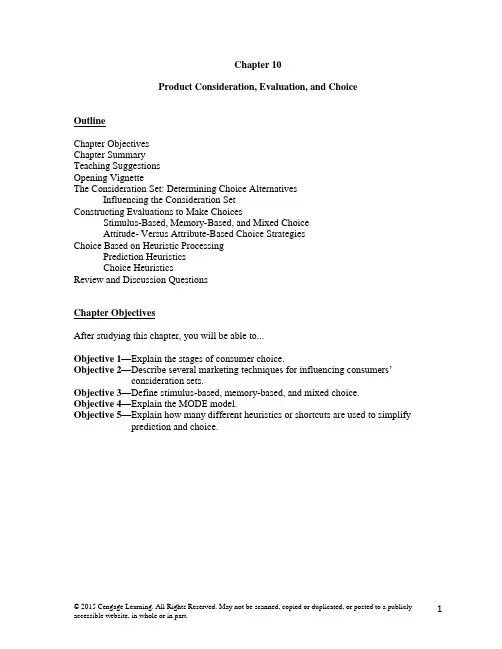
Chapter 10Product Consideration, Evaluation, and ChoiceOutlineChapter ObjectivesChapter SummaryTeaching SuggestionsOpening VignetteThe Consideration Set: Determining Choice AlternativesInfluencing the Consideration SetConstructing Evaluations to Make ChoicesStimulus-Based, Memory-Based, and Mixed ChoiceAttitude- Versus Attribute-Based Choice StrategiesChoice Based on Heuristic ProcessingPrediction HeuristicsChoice HeuristicsReview and Discussion QuestionsChapter ObjectivesAfter studying this chapter, you will be able to...Objective 1—Explain the stages of consumer choice.Objective 2—Describe several marketing techniques for influencing consumers’ consideration sets.Objective 3—Define stimulus-based, memory-based, and mixed choice.Objective 4—Explain the MODE model.Objective 5—Explain how many different heuristics or shortcuts are used to simplify prediction and choice.Chapter SummaryConsumer choice involves choosing one brand from a set of products. The set of products that consumers think about and evaluate—the consideration set—usually consists of fewer than seven brands, but the best brand is not always included in the consideration set. The more consumers think about some brands, the more difficult it is to think about other brands (the part-list cuing effect). Moreover, a given brand can seem attractive (the attraction effect) or unattractive depending on what other brands are included in the consideration set. Compromise brands, or brands that are average on multiple dimensions, often have an advantage over brands that are good on some dimensions and bad on others (the compromise effect). Attraction and compromise effects are often more pronounced when consumers feel the need to justify or explain their decisions to themselves or others.After the consideration set has been determined, consumers need to evaluate the differences in features and attributes between the considered brands in order to make a choice. When consumers can directly and physically observe all relevant brands in the consideration set and the brand attributes, they make a stimulus-based choice. But when brand alternatives are drawn from memory, choice is memory-based. Mixed choice combines both stimulus-based and memory-based choices. In addition, choice often involves focusing on differences among brands and using these differences as reasons or justifications for making decisions. These differences may be general (attitude-based choice) or specific (attribute-based choice), depending on the accessibility (salience in memory) and the diagnosticity (relevance) of the information used as a basis for choice.Choice heuristics are mental shortcuts that simplify difficult decisions. Consumers use many different choice heuristics. Sometimes consumers focus on only one attribute (the lexicographic heuristic), and sometimes consumers eliminate brands that do not have a desired feature (the elimination-by-aspects heuristic). On other occasions, consumers compare two brands at a time and subtract the difference in the values of the attributes (the additive-difference heuristic). In other circumstances, consumers can focus on only one brand and choose the brand if it is satisfactory on all attributes (the conjunctive heuristic) or satisfactory on one attribute (the disjunctive heuristic). Finally, consumers may simply add up a product’s good and bad features and choose the best overall brand (the frequency of good and bad features heuristic). Choice heuristics can lead to poor decisions when consumers overlook important information. Nevertheless, consumers are often forced to use choice heuristics when information overload, time pressure, or other stresses increase the difficulty of decision making.TEACHING NOTESTeaching Suggestions1. Ask a student which pizza places he or she would recommend to friends visiting from out of town. If the student recommends only one place, then brand loyalty may be evident. However, the student will probably recommend more than one place but no more than nine places. You can use this example to illustrate memory- vs. stimulus-based choices. Memory-based consideration sets typically include fewer brands than stimulus-based consideration sets. You can demonstrate this by bringing a copy of the Yellow Pages with you or conducting a quick search on the Internet to show just how many different pizza places exist in the area (many more than nine, most likely). Then, ask if there are additional restaurants that the student might recommend.2. Have students go to a grocery store and locate several products that come in three different sizes. Ask them to observe if marketers are using a compromise effect as a strategy with these brands.3. This chapter provides an opportunity to demonstrate some of the choice heuristics: lexicographic, elimination-by-aspects, conjunctive, additive-difference, and frequency of good/bad features. Ask students to consider the three brands below, rated 1-7 on four key attributes, where 1 is the worst rating and 7 is the best rating. Importance weights (weight) for the four attributes are provided, as are the minimum requirements for each attribute (minimum).Ratings from 1-7Attribute weight Brand A Brand B Brand C Minimumstyle 0.30 4 1 7 4color 0.20 4 5 2 4comfort 0.25 4 5 2 4durability 0.25 4 5 2 51.00Next, demonstrate that Brand A would be chosen if a consumer used a multi-attribute model (e.g., information integration) to compute overall ratings. Interestingly, Brand A has no real competitive advantage because it is rated 4, or average, on each attribute, while Brand B is above average on every attribute except style, and Brand C is the opposite.Multi-attribute ModelBrand A Brand B Brand C1.20 0.302.100.80 1.00 0.401.00 1.25 0.501.00 1.25 0.504.00 3.80 3.50The conclusion is similar using an additive difference heuristic. Comparing brands A, B, and C, one at a time, by subtracting differences and multiplying the differences by importance weights, Brand A is superior to both Brands B and C, and Brand C is dominated by A and B.Additive-DifferenceA vs.B B vs.C A vs. C0.90 −1.80 −0.90−0.20 0.60 0.40−0.25 0.75 0.50−0.25 0.75 0.500.20 0.30 0.50Next, show that Brand C would be chosen if a consumer employed the lexicographic heuristic. Although Brand C performs poorly in three of the four attributes, it is rated highest (7) on the most important attribute (style), which comprises 30% of the overall weight. Finally, demonstrate that no brand would be selected if a consumer used the conjunctive heuristic, because none of the three brands meet the minimum requirement on all four attributes. This may lead to an interesting discussion about how consumers’ respond when the market doesn’t meet their needs. They can:1. Postpone their purchase until a new product meets their requirements2. Reduce their minimum requirements, i.e., compromise their standards3. Reconsider their ratings and increase the scores until a brand meets the minimum criteria4. Get out of the market altogether by changing product categories.By comparing the outcomes of several heuristics, students will see different brands may be chosen depending on which heuristic or decision model is used.Opening VignetteThe opening vignette describes a typical situation where a consumer may be faced with a plethora of choices in a given product category. Often when consumers are faced with too many choices, they try to simplify by using shortcuts or “rule s of thumb,” called heuristics. The Consideration Set: Determining Choice AlternativesIt is important to note that consumers employ a variety of decision-making processes, depending on the nature of the task, as well as motivation, ability, and opportunity to process the information.▪ A consideration set is the group of brands that consumers think about buying when they need to make a purchase.▪The brands included the consideration set can come from:1.An evoked set of brands2.Brands discovered during external information search3.Point-of-purchase informationInfluencing the Consideration SetAs the number of brands in the consumer’s consideration set increases, the likelihood of a brand being chosen decreases. Accordingly, marketers try to limit the number of competitors’ brands in the consideration set.1. Part-list cuing involves presenting the names of just some brands whenconsumers are trying to recall as many brands as possible.▪As a partial list of brands becomes more strongly connected with theproduct category, it becomes difficult for the consumer to think of otherbrands.2.The attraction effect occurs when a target brand appears more desirable because itis compared to inferior brands within the same cluster, or subgroup.3.The compromise effect occurs when a middle-of-the-road brand appearsacceptable on all features and is chosen over brands that offer good and badfeatures.▪The compromise brand seems like a safe choice.▪The probability of buying a compromise brand increases when consumers are concerned about making a bad decision.▪Figure 10.2 provides a graphical representation of the attraction andcompromise effects.Constructing Evaluations to Make ChoicesConsumer choice involves selecting one product or brand from a set of possibilities. Marketers must understand three critical issues:1. The brands in the consideration set2. The types of information used to detect and evaluate the differences among theconsidered alternatives3. How this information is ultimately used in the choice process▪Stimulus-based choice involves consumers directly and physically observing all relevant brands in the consideration set and their brand attributes.▪Memory-based choice is a situation where none of the relevant brands and attributes is directly and physically observable.▪Mixed choice is a situation where consumers can see some brands but must rememberothers.▪Attitude-based choice occurs when consumers form overall evaluations and general impressions of brands.o Consumers typically rely on attitudes when drawing information frommemory.o Attitude-based choice can occur only if consumers have previously formed attitudes toward a brand.▪Attribute-based choice occurs when consumers compare the specific attributes or features of each brand.o When brands are similar and information is diagnostic, attribute-based choice is preferable.o In general, attitudes are more accessible, and attributes are more diagnostic.▪The MODE model holds that motivation and opportunity will determine the processes that influence consumer choice.o When motivation and opportunity are high, consumers are likely to deliberate and use attribute-based choice.o Figure 10.3 provides a graphical representation of the MODE model.Choice Based on Heuristic ProcessingWhen consumers think carefully about decisions, using all relevant information and considering all implications, they are engaging in systematic processing. In contrast, when consumers are unwilling or unable to use careful and effortful decision-making strategies, they are using heuristics that enable them to make decisions quickly and easily.Persuasion Heuristics1.The length-implies-strength heuristic suggests “size matters.”2.The liking-agreement heuristic is based on the assumption that consumers usuallyagree with people they like3.The consensus-implies-correctness heuristic is synonymous with “the bandwagoneffect.”Prediction HeuristicsGood consumer decision making often requires accurate probability or likelihoodjudgments about events, such as accurate predictions about future productperformance.1.The representativeness heuristic involves consumers making predictions based onperceived similarities between a specific target and a general category.▪Private store brands often package their products in boxes with graphics similar to national brands, hoping that the similarities will lead consumers topredict that the store brands will perform similarly to leading national brands.2.The availability heuristic is used by consumers to make predictions based on howeasily they can retrieve information from memory.▪Events that are highly memorable because of media exposure, frequent exposure, or recent exposure, are easily recalled.3.The simulation heuristic is used by consumers to make predictions based on howeasily an event or a sequence of events can be imagined or visualized.▪If an event or sequence of events is easy to imagine, it tends to beoverestimated. If an event or sequence of events is difficult to imagine, ittends to be underestimated.4.The anchoring-and-adjustment heuristic involves consumers making predictionsbased on a first impression or an initial judgment (or anchor) and then shifting(adjusting or fine-tuning) this judgment upward or downward depending on theimplications of the imagined possibilities.▪Consumers rarely adjust enough, and as a result, final judgments tend to be too close to initial judgments.▪Figure 10.4 provides examples of the prediction heuristics.Choice Heuristics1.The lexicographic heuristic (or single-attribute heuristic) involves comparing allbrands on one key attribute, such as price, size, weight, reliability, durability,calories, sugar, etc., and choosing the brand that performs the best on that singleattribute, while generally ignoring the other attributes.2.Consumers using the elimination-by-aspects heuristic reject all brands that do nothave a key feature they want.3.The additive-difference heuristic compares two brands at a time, one attribute at atime, and subtracts the evaluative differences. This heuristic requires more effortbecause arithmetic is used. However, more effort can lead to better decisions.4.The conjunctive heuristic involves setting minimum values for all relevantattributes and selecting the first brand that meets this value for each attribute.5.The disjunctive heuristic sets an acceptable value, rather than a minimum value,for all relevant attributes. Consumers select the first brand that meets this value on one particular attribute—which is not necessarily the most important attribute.6.The frequency of good and bad features heuristic involves counting the number ofgood and bad product features and choosing the brand with the greatest difference between the two.Answers to Review and Discussion Questions1.How can marketers increase the likelihood that their brands will be included inconsumers' consideration sets?Salient and vivid promotional campaigns and wide distribution networks increase brand awareness, which increases the likelihood that a brand will be included in consumers’ consideration sets.2.How can marketers use the part-list cuing effect to decrease the likelihood thatcompetitors' brands will be included in consumers' consideration sets?Mentioning some competing brands by name makes it difficult to think of otherunmentioned competing brands.3.Why does the trade-off contrast effect occur?Trade-offs are often difficult to make, so consumers often use trade-offs betweenattributes on multiple brands to help them decide what trade-off level seems reasonable.4.Describe a situation in which you purchased a compromise brand. Why doescompromise seem like such a compelling reason on which to base a choice?Purchasing a brand that is average in price and quality is easy to justify to oneself and others. If an average brand is adequate, why pay more for a fancier brand?5.How does the availability heuristic influence how consumers make predictions aboutproducts?Easy-to-remember events seem likely, and difficult-to-remember events seem unlikely. If it is easy to remember many successful prior experiences with a product, consumers predict that future successful experiences are likely as well.6.How might the law of large numbers be related to word-of-mouth marketing?Word-of-mouth marketing is simply when marketing messages, product information, and/or peoples’ opinions of the product are passed from person to person throughinformal conversation. A large number of satisfied customers implies that a product must be a good product.7.When are consumers likely to use a choice heuristic? When are they unlikely to do so?Consumers are likely to use choice heuristics when involvement is low, choice difficulty is high, or risk is low. Consumers are unlikely to use choice heuristics when involvement is high, choice difficulty is low, or risk is high.8.Choice heuristics are often noncompensatory. Explain what this means and explainhow this can lead to bad choices.A noncompensatory choice heuristic means that a good attribute cannot compensate ormake up for a bad attribute. Whenever consumers overlook some attributes, they may make a bad decision that they might later regret.9.Some choice heuristics involve comparing several brands on the same attribute or setof attributes. Describe a situation in which you used one of these choice heuristics.Consumers often compare many brands on price before making a purchase decision.Other important attributes could be used as well.10.Some choice heuristics involve focusing on one brand at a time rather than makingcomparisons across brands. Describe a situation in which you used one of these choice heuristics.Consumers often consider only one brand when making a purchase decision, even when that decision is major. If the first brand considered seems adequate, consumers often choose that brand rather than look further.Answers to Short Application Exercises and Managerial Application Challenges Student responses, answers, and examples will vary on these open-ended Short Application Exercises and Managerial Application Challenges.。
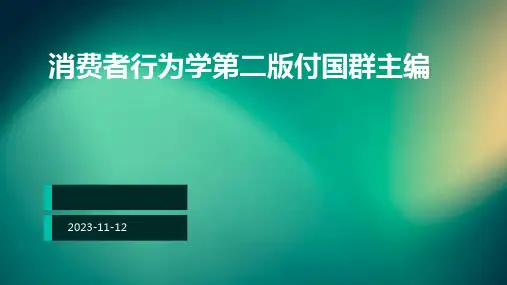

消费者行为学(第2版)群体成员之间的互动方式等表现出浓厚的兴趣。
社会心理学家对下列消费者行为研究领域有着特别的关注:某一个体是如何影响另一个体的购买行动的,信息是如何在群体内和群体间传播的,哪些因素影响消费者对产品和公司的认知,家庭怎样影响消费者行为,以及相关群体是怎样影响消费者行为的,等等。
4.人类学人类学是从历史的角度研究人类及其文化的科学。
人类学对民俗、宗教、传说等文化传统和民间习俗的研究,为研究和探索消费者特定心理与行为的文化渊源提供了依据。
例如,大多数印度人信奉印度教,他们将牲畜猪、牛奉为神物,宰杀猪、牛或食用猪肉、牛肉是对印度教和教徒最大的亵渎。
诸如此类的风俗与禁忌,对消费者选择商品的影响是深远而直接的。
5.经济学经济学是一门研究稀缺资源配置和利用的社会科学。
最初从事消费者行为研究的学者大都是接受过经济学知识训练的。
20世纪20年代至50年代,美国密歇根大学的卡陶纳(G.Katona)曾系统地研究过经济因素对个体购买行为与购买信心的影响。
至今,仍有不少学者运用经济学原理和方法分析消费者行为。
例如,美国哈佛大学经济学家哈维·莱宾斯坦(Harvey Leeibenstein)将消费者需求分为功能性需求和非功能性需求,在此基础上运用经济学的效用分析理论,探索消费过程外部效用对消费者行为的影响,从而得出了很多新的、富有价值的研究成果。
经济学原理在帮助经理人员制定价格、评价影响某种特定产品供需状况的各种因素,以及发展促销策略等方面,都极有价值。
比如,一些烟、酒厂家限量推出某种价格昂贵的“特制品”“精品”,并在广告宣传中强化其“稀有性”特点,实际上就是运用经济学原理,提高这些产品在消费者心目中的价值,从而促使消费者购买。
1.3.2 消费者行为学的研究方法消费者行为学是以行为科学研究的一般方法为基础,吸纳、借鉴、创新、发展多门学科的研究方法,形成了自己的研究方法体系。
消费者行为学研究方法主要有观察法、实验法、问卷调查法、投射法四种。
参考文献[1]J. 布莱思.消费者行为学精要[M].北京:中信出版社,2003.[2]L. G. 希夫曼,L. L. 卡纽克.消费者行为学(第七版)[M].上海:华东师范大学出版社,2002.[3]蔡少宗.消费者行为学[M].北京:清华大学出版社;北京交通大学出版社,2010.1.[4]菲利普·科特勒.市场营销管理(亚洲版·第二版)[M].北京:中国人民大学出版社,2003.7.[5]菲利普·科特勒.营销管理(第十一版)[M].上海:上海人民出版社,2004.3.[6]冯丽云,孟繁荣,姬秀菊.消费者行为学[M].北京:经济管理出版社,2004.[7]符国群.消费者行为学(第二版)[M].北京:高等教育出版社,2010.[8]龚振,荣晓华,刘志超.消费者行为学[M].大连:东北财经大学出版社,2002.1[9]江林.消费者行为学[M].北京:首都经济贸易大学出版社,2009.[10]利昂·G. 希夫曼.消费者行为学(第十版)[M].北京:中国人民大学出版社,2011.5.[11]林建煌.消费者行为[M].北京:北京大学出版社,2011.[12]林晓航.消费者动机分析与营销策略[J].中山大学学报论丛,2006,26(2).[13]卢泰宏.消费者行为学[M].北京:高等教育出版社,2005.[14]罗子明.消费者心理学[M].北京:清华大学出版社,2002.[15]迈克尔·R. 所罗门.消费者行为学(第三版)[M].北京:经济科学出版社,2000.[16]迈克尔·R. 所罗门,卢泰宏,杨晓燕.消费者行为学(第10版)[M]. 北京:中国人民大学出版社,2014.[17]迈克尔·R. 所罗门,卢泰宏.消费者行为学[M].北京:电子工业出版社,2006.[18][美]所罗门,[美]拉博尔特. 消费心理学:无所不在的时尚(第2版)[M].北京:中国人民大学出版社,2014.[19]荣晓华.消费者行为学[M].大连:东北财经大学出版社,2006.[20]王长征.消费者行为学[M].武汉:武汉大学出版社,2003.5.[21]王曼等.消费者行为学(第二版)[M].北京:机械工业出版社,2011.8.[22]吴健安,郭国庆.市场营销学[M].北京:高等教育出版社,2006.[23]徐俊昌.消费者行为学[M].北京:机械工业出版社,2012.[24]张中科,等.消费者行为学(第一版)[M].北京:中国人民大学出版社,2011.12.[25]吴柏林.消费者行为学:基于消费者洞察的营销策略[M].北京:机械工业出版社,2015.[26][美]德尔·I. 霍金斯,符国群.消费者行为学(英文原书第12版)[M].北京:机械工业出版社,2014.。